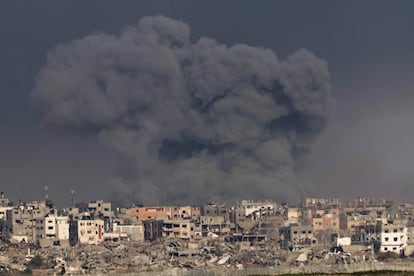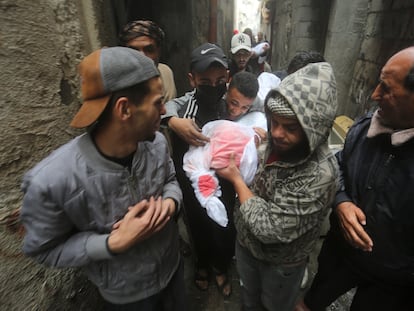The Gazans resigned to staying in the north: ‘We look for anything to stay alive’
Tens of thousands of Palestinians remain in the northern part of the enclave, despite evacuation orders. Without humanitarian aid, which is restricted to the south, every day is an odyssey to find food and water

After fleeing from house to house for weeks in search of safety that never came, Kayed Hammad, 60, has resigned himself to staying in northern Gaza, even if it means eating legumes soaked in water because there is no butane gas to cook them. “I don’t want to go south. I am not going to repeat in 2023 what my parents did in 1948. I prefer to die here. What’s more, people are dying on the way south,” he says in voice messages he records when he can charge his cell phone and the internet isn’t down.
He is speaking from Gaza’s largest refugee camp, Jabalia. That’s where his parents ended up after the Nakba, the flight and expulsion of some 750,000 Palestinians during the first Arab-Israeli war, 75 years ago. And that’s where the images of mass arrests of Palestinians are being taken. It’s also the site of door-to-door combats, such as the fight in which Hamas militants killed nine Israeli soldiers on Tuesday — the second-deadliest ambush of the war. Although the Israeli army has been zealously attacking the south of Gaza since the ceasefire ended on December 1, it has another foot in the north, where it is intensively bombarding Jabalia and Shuyaia, a neighborhood in Gaza City, the capital.
The north — where only one hospital functions and the Israeli army has just raided another and blown up a U.N. school — is a succession of uninhabitable or destroyed houses, of plains of rubble and missile craters. It’s a desolate landscape left after two months of Israeli bombings, the intensity of which has not been seen in decades, as shown by aerial and on-the-ground images. In October, Israel ordered the 1.1 million inhabitants in the north to head south. The vast majority ended up leaving. Nobody knows how many stayed put. The United Nations does not dare to estimate the figure, as chaos reigns and the Israeli army is keeping the north incommunicado. At least tens of thousands of people are living in U.N. shelters and relatives’ homes in the north. Without humanitarian aid — which Israel limits to southern Gaza — their lives are a daily odyssey to find food, water and shelter.
“We don’t look for food. You can’t really call it that. You have some bread, and you look for a sauce. Or a can of tuna or beans. We look for anything to stay alive. Often we have left uncooked beans in water so that they can be eaten the next day, with a little salt and a pepper,” says Hammad. Cooking them would require butane gas, which is now a precious commodity. “I was amused when a friend [from abroad] told me: ‘You have to boil the water to avoid diseases,’ and I thought: ‘It’s either that we don’t have butane or we have just enough to cook or to warm ourselves a little.’ People have started to light wood to make a fire.”

The week-long ceasefire at the end of November gave Gaza a small respite. Not only because there we no bombings, but also because dozens of trucks carrying humanitarian aid were allowed for the first time to cross the Israeli military checkpoint that divides both parts of Gaza. “They say flour came in, but nothing has come to me,” he says. Hammad says he found a kilo in a store and mixed it with water to try to make bread in a frying pan.
With the stores half empty, the only things left are vegetables, bread, rice, preserves — the products of a subsistence economy. “The water is not drinkable and there is less and less food,” he laments. Many Gazans are drawing on their savings — it’s common in the enclave for people to keep part of their money in cash, sometimes in dollars or Jordanian dinars. “What was worth four shekels [the equivalent of one dollar] is now worth 20 or 25. Everyone has raised prices due to the lack of products.”
Waiting nine hours to get bread
With food running low, Gazans risk their lives to avoid dying from starvation. “You have to wait for the bombing to calm down. In the end, you ended up waiting eight or nine hours to get bread. And, when you get there, there is no more. They have also bombed the bakeries,” says Hammad.
Hammad almost feels privileged, because one of his nephews installed solar panels for his business, so there is electricity in his brother’s house, where he has ended up with his wife and children. Others in Jabalia, where it’s been raining for days and the temperature drops to 55.4ºF (13ºC), are less fortunate. Images from the city show displaced families in tents flooded with water and mud.
Before reaching Jabalia, Hammad went to four different houses in the capital. His home no longer exists. It was destroyed in the bombings. The same thing happened in Israel’s Operation Cast Lead (2008-2009) and in 2003, during the Second Intifada, when his workshop and car were also destroyed.
For four days he “felt no danger.” Then missiles struck nearby towers, and he decided to flee at night to his sister’s house, in another neighborhood. Two nights later, the sound of the bombs grew closer and he moved to a cousin’s home. “We only stayed one night, because it felt like the bombs were practically falling on top of our heads,” he remembers. After two more nights with a brother-in-law, he found some stability at the home of his wife’s uncle, near Al Shifa hospital. “I was going to see the people [the thousands of displaced] who were there. They were living in conditions from 200 years ago. They slept on the floor. Even the children, who were given milk mixed with water, which is not even fit for an animal,” he recalls. He stayed until mid-November, when Israeli troops surrounded the hospital and seized control. He then returned to his hometown, Jabalia.
In three months, he has gone from planning a trip to Spain — where he lived in the 1990s — to struggling to navigate the present to worrying about the future — Israel intends to extend the war in its current form until at least February. “What awaits me when the war is over? Living on the street: without money, without work, without a house, without furniture, without clothes... without anything at all,” he says.
Ten to a home
The mayor of Gaza City, Yahya Sarraj, is also still in the north. He explains that many families are squeezed into houses that are just a few square meters in size. Some of them used to live in buildings that have now been destroyed. Others come from homes that are still standing, but have lost their exterior walls or windows, so the cold creeps in. “Here the community is used to supporting each other in difficult times. A small house can now accommodate several families. To make it easier, they sometimes separate women and children in a room; and men and boys, in another. Each one can fit about 10 people or more,” says Sarray, who was appointed mayor by the Hamas government in 2019.
Searching for basic necessities are part of the routine for survival. “People spend a lot of time looking for water. They fill large plastic drums and carry them for a long time to their home, or whatever can be considered their home or refuge.” It’s the same process to refill a butane cylinder. “There is very little. Sometimes they wait for hours to end up coming back with just a little bit.” Almost no one can transport them by car, due to the lack of fuel. Israel is only allowing limited amounts of fuel, at the request of the United States, to enter the south. “So people either walk, or ride a bicycle, or take it by cart,” he points out.
Many people are in shelters, such as schools, public spaces or churches (Gaza City is home to a small Christian community, of about 1,000 people), he explains. “But those places are not completely safe either. And they don’t have enough bathrooms or hot water. And if someone gets sick, it is very difficult for them to have somewhere to go,” he adds.
The sick may have once considered going to the Al Awda hospital, in Jabalia, but Israeli troops have surrounded it since December 5, and two health workers have already died, according to the World Health Organization. The center is sheltering about 250 people (including patients, staff and displaced people) who do not dare leave. One of them, Mohamed Salha, says in a voice message that the Israeli snipers shoot at the windows, so they have moved to the basements and inner corridors. In the hospital, he says, there is still the body of a person who was killed on the first day of the siege. “It is a woman who accompanied her sister-in-law to the maternity ward,” says Salha, who records his messages in the most protected part of the hospital, and fearfully goes up to send them.
Sign up for our weekly newsletter to get more English-language news coverage from EL PAÍS USA Edition
Tu suscripción se está usando en otro dispositivo
¿Quieres añadir otro usuario a tu suscripción?
Si continúas leyendo en este dispositivo, no se podrá leer en el otro.
FlechaTu suscripción se está usando en otro dispositivo y solo puedes acceder a EL PAÍS desde un dispositivo a la vez.
Si quieres compartir tu cuenta, cambia tu suscripción a la modalidad Premium, así podrás añadir otro usuario. Cada uno accederá con su propia cuenta de email, lo que os permitirá personalizar vuestra experiencia en EL PAÍS.
¿Tienes una suscripción de empresa? Accede aquí para contratar más cuentas.
En el caso de no saber quién está usando tu cuenta, te recomendamos cambiar tu contraseña aquí.
Si decides continuar compartiendo tu cuenta, este mensaje se mostrará en tu dispositivo y en el de la otra persona que está usando tu cuenta de forma indefinida, afectando a tu experiencia de lectura. Puedes consultar aquí los términos y condiciones de la suscripción digital.
More information
Archived In
Últimas noticias
Most viewed
- Sinaloa Cartel war is taking its toll on Los Chapitos
- Oona Chaplin: ‘I told James Cameron that I was living in a treehouse and starting a permaculture project with a friend’
- Reinhard Genzel, Nobel laureate in physics: ‘One-minute videos will never give you the truth’
- Why the price of coffee has skyrocketed: from Brazilian plantations to specialty coffee houses
- Silver prices are going crazy: This is what’s fueling the rally











































